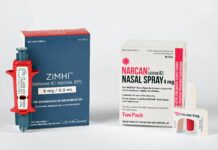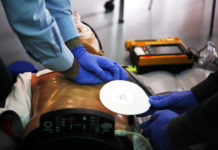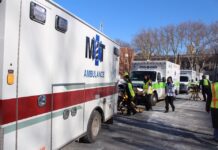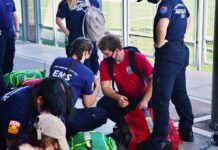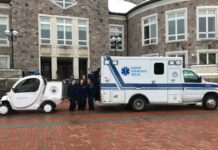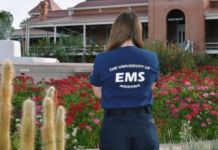| Download PDF (Available Soon) | |
| Author and Article Information |
Background
In response to the devastating impact of the coronavirus disease of 2019 (COVID), multiple vaccines were developed and distributed for mass vaccination. To match the workforce demand for vaccinators to administer the vaccine, the state of California initiated a local optional scope of practice that allowed emergency medical technicians (EMTs) and paramedics to administer the COVID vaccines. Here, we describe the creation and operation of a COVID vaccine clinic staffed by the University of California Davis Fire Department (UCDFD) on a college campus in order to contribute to the efforts towards mass vaccination.
UCDFD is an all-risk fire department in Yolo County, California that provides emergency medical services, fire suppression, technical rescue, hazardous materials mitigation, and community risk reduction services for the UC Davis college campus, as well as augmenting similar services in surrounding communities. The department is staffed by career firefighters, student firefighters, and student emergency medical technicians (EMTs).
At the time of the vaccine rollout, the UC Davis undergraduate campus employed 23,300 faculty and staff and served 46,000 matriculated students. Because of this large population, a large-scale vaccination program was vital for campus life to return to normal.
As a campus health leader, UCDFD was uniquely positioned to assist with this vaccination effort. UCDFD has a long history of proactive participation in UC Davis campus health, wellness, and safety events. The department has 21 career firefighters who are all licensed EMTs. Additionally, the department has active student EMT (SEMT) and student firefighter (SFF) programs. The SEMTs are UC Davis students who are licensed EMTs and employed by the department. In addition to a role as first responders on campus, SEMTs also teach a full complement of health education classes, host public education and outreach events on campus, and provide EMT coverage at large events. This work situates the UCDFD as prominent campus safety leaders and health ambassadors.
The SFFs are UC Davis students that work alongside career firefighters and respond to emergencies on and around the campus. They are licensed EMTs who are simultaneously working through the California State Fire Marshal firefighter-1 curriculum. The SFFs and SEMTs work together to provide world-class service to the UC Davis campus community. The career staff, SEMTs, and SFFs acknowledged the need for vaccinators and voluntarily chose to perform this service.
According to the scope of practice guidance from the State of California and Yolo County, all potential vaccinators were required to undergo an in-person, 3-part training session through the county emergency services agency. Multiple training sessions were organized several days before the clinic launch.
The first portion of the training was a didactic portion and consisted of a two-hour lecture followed by a written exam. The course content included a review of the clinic protocol, contra-indications to the vaccine, treatment for adverse reactions to the vaccine, and intramuscular injection training.
After passing the didactic portion of the training, students progressed to the second portion of the training which was hands-on. This portion began with simulated needle injections on artificial injection training pads and progressed to injecting humans. The third portion of the training consisted of supervised injections in the clinic. Each newly trained vaccinator was shadowed by a clinic nurse until competency was demonstrated.
After competency was established, the vaccinators administered COVID vaccinations independently. Supervision of patients and EMTs was provided by nurses from the Student Health and Counseling Service (SHCS) on campus, and by nurses hired specifically for the supervisory role. In addition, medical oversight was provided by physicians from the SHCS and campus Occupational Medicine.
Logistics
The vaccine clinic administered its first vaccine in February 2021. The clinic was open seven days per week from 8:30 AM to 4 PM with a 45-minute mid-day closure. Vaccinator shifts were broken into 3.5-hour morning shifts and 3.25-hour afternoon shifts. An online shift scheduling program was established for open sign-up.
The clinic required a large space to accommodate the staff and the patient group while maintaining the requisite 6 feet of personal space required for social distancing. The campus was closed for in-person instruction and research beginning in March 2020, leaving the large UCD Activities and Recreation Center ballroom available for the clinic. Parking, usually pay by hour or permit, was made unrestricted and free to all patients during the vaccination clinic.
Collaboration
Vaccines arrived in multidose vials. The vaccine required storage at -112ºF to ‑76ºF, which required specialized freezers. The frozen vaccine was moved to the vaccination site by vaccine clinic employees. Once there, pharmacists were required to thaw the vaccine and prepare it in single-dose syringes. Pharmacists were mobilized from the School of Veterinary Medicine and from the SHCS.
Surface disinfection was a primary concern during this era of the pandemic. Every surface required disinfection between each guest. The campus had a pre-existing program called Aggie Public Health Ambassadors comprised of undergraduate students that provided public health messaging to the campus prior to the pandemic. They contributed to the vaccine clinic by sanitizing surfaces in the clinical space after clients were finished with their vaccine session. In addition, they escorted patients through the registration and vaccination process on-site.
A unique partnership that developed was a collaboration with a local organization called Healthy Davis Together (HDT). This was a grant-funded program in the community, which scheduled and administered COVID testing to the general public. When HDT began, resources were shared and redundancy decreased. Individuals who staffed the COVID testing kiosk encouraged vaccination by handing out stickers for vaccination. When demand for vaccines increased, employees at the COVID kiosk were also asked to work at the UC Davis vaccine clinic. There, they were responsible for scanning QR codes, sanitizing efforts, and greeting services. HDT supported links to vaccination scheduling sites on their website.
Standing up and operating a vaccine clinic on the UC Davis campus was a critical and time-sensitive endeavor. The resultant clinic was capable of administering 1200 vaccines per week. It was maintained at full capacity for approximately one year from February 1, 2021 to February 4, 2022, before transitioning to a smaller-scale operation. The clinic administered 20,015 vaccines over the course of that year. We believe the vaccination program, coupled with other community efforts, directly impacted the incidence of COVID on the campus and in the community. When COVID test positivity rates were 22% in the state, they were only 5% on the campus and surrounding city. When COVID test positivity rates were 17% in the state, they were only 1% on the campus and in the surrounding city (https://www.politico.com/news/magazine/2022/09/25/the-city-that-survived-covid-better-than-the-rest-of-us-00050564).
The process involved a vast network of collaboration from campus and community partnerships. When responding to future public health crises, resources from every source should be engaged to match the work needed.
Author & Article Information
Stephanie Warrior, EMT is a Student EMT for the University of California – Davis Fire Department, and has been serving in this role since January 2022. Sun Chu, EMT is a Student EMT for the University of California – Davis Fire Department since 2021. Nathan Trauernicht, MPA, BS FPST, CFO, CEMSO, CTO, MIFireE, CA certified Fire Chief #30 is the Fire Chief for University of California – Davis, providing overall leadership and direction to a department that serves a population of over 40,000. He has served the fire service since 1993. Nathaniel Hartinger is the Deputy Fire Chief for the University of California – Davis Fire Department. He directs the Operations and Safety Division. Scott Hatcher is the EMS Captain for the University of California – Davis Fire Department. He also serves as the Pre-Hospital Care Coordinator for UC Davis Fire Department. Lisa Mills, MD is the Medical Director for the University of California – Davis Fire Department since 2018.
Author Affiliations: From University of California – Davis Fire Department – in Davis, California (S.W., S.C., N.T., N.H., S.H., L.M.).
Address for Correspondence: Lisa Mills | Email: ldmills@ucdavis.edu
Conflicts of Interest/Funding Sources: By the JCEMS Submission Declaration Form, all authors are required to disclose all potential conflicts of interest and funding sources. By the JCEMS Submission Declaration Form, all authors are required to disclose all potential conflicts of interest and funding sources. All authors declared no conflicts of interest. The authors declared that they received funding from the University of Pennsylvania Undergraduate Assembly and Center for Resuscitation Science to support the training event.
Authorship Criteria: By the JCEMS Submission Declaration Form, all authors are required to attest to meeting the four ICMJE.org authorship criteria: (1) Substantial contributions to the conception or design of the work; or the acquisition, analysis, or interpretation of data for the work; AND (2) Drafting the work or revising it critically for important intellectual content; AND (3) Final approval of the version to be published; AND (4) Agreement to be accountable for all aspects of the work in ensuring that questions related to the accuracy or integrity of any part of the work are appropriately investigated and resolved.
Submission History: Received April 18, 2023; accepted for publication August 17, 2023
Published Online: Pending
Published in Print: Pending
Reviewer Information: In accordance with JCEMS editorial policy, Advice and Practice manuscripts are reviewed by the JCEMS Editorial Board and, as needed, independent reviewers. JCEMS thanks the Editorial Board members and independent reviewers who contributed to the review of this work.
Copyright: © 2023 Warrior, Chu, Trauernicht, Hartinger, Hatcher, & Mills. This is an open access article distributed under the terms of the Creative Commons Attribution 4.0 International (CC BY 4.0) License, which permits unrestricted use, distribution, and reproduction in any medium, provided the original author and source are credited. The full license is available at: https://creativecommons.org/licenses/by/4.0/
Electronic Link: Pending

